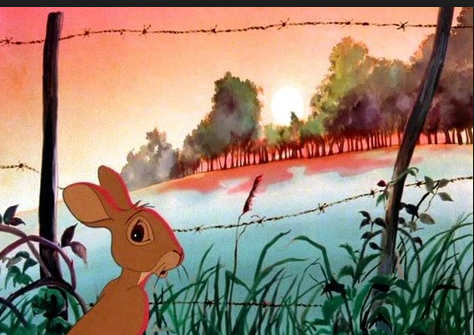In
Watership Down, Adams attempts to
move away from anthropomorphizing the rabbit main characters (though they still
contain the human fantasy elements of prophecy) and instills his narrative with
rabbit facts at the beginning of each chapter. Never do the rabbits hold a sword or
living in an abbey. Instead, their lives are watched through a human lens, so
we see their interactions in our own terms—as prophecy, friendship, love, myth. The story
follows Hazel and his prophetic brother Fiver, who has a vision of their home
warren’s destruction. They seek a safe place to build a new warren away from
the human activity, which is of course, how their warren is destroyed—even in pastoral
England. While my memory of the novel isn’t focused around the horror of human
expansion (it’s very rich in worldbuilding, the main reason I love it), that’s the motivating force of the
novel. Human destruction starts Fiver and Hazel on this epic journey.
(Aside:
I will point out that my only surviving memory of the 1978 cartoon version is
the bulldozers destroying the warren, which FREAKIN’ TERRIFIED me.)
Now,
for Mort(e). Originally, it caught my
attention as the first novel in a wave of anthropomorphic books that started
appearing in the early twenty-teens (more on that in a future post). While many
of these books were published as literary fiction, Mort(e) walked the line between speculative and literary, enjoyed in both
areas. Without giving away spoilers, basically animals gain “sentience” and
also become bipedal, so they can use guns and drive cars. They overthrow humanity
though some “pets” are still on the lookout for their former “owners” and some
animals do ally with the humans. My description doesn’t do the series justice
since it’s one of those books that sounds like a mess when you try to describe
it.
These
novels are on different ends of the anthropomorphic spectrum, but they differ
from Redwall or another classic, The Wind in the Willows, due to the
tension around how humans and nonhumans interact. One could argue that Watership Down encourages us to see the
natural world differently, particularly something as common as a rabbit, by
giving this nonhuman its own mythology, language, customs, culture, etc.
Meanwhile, Mort(e) asks the reader to
consider, what if the nonhumans could hold a gun and judge us? What would the factory farmed turkeys do? What about the abused
fighting dogs? In both cases, the power of anthropomorphic novels becomes
clear, but the question is, why do we need
to see nonhumans as ourselves in order to respect them? As human writers
continue to write about nonhumans, I’m looking forward to watching the genre
develop.
Previous Essays
Eco-Speculation #1: Blame Tolkien
Eco-Speculation #2: Animals Among Us
Previous Essays
Eco-Speculation #1: Blame Tolkien
Eco-Speculation #2: Animals Among Us
Posted by Phoebe Wagner, a writer living in the high desert with her husband and cats. She can be found on Twitter @pheebs_w
